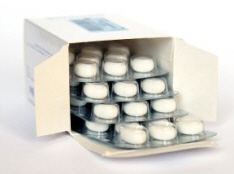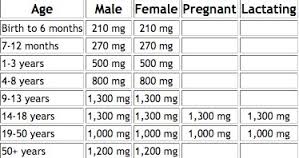 Calcium supplementation has long been known to help the development of bone growth in the early years so that older men and women have a lower risk of suffering from osteoporosis. Bone loss is a natural occurrence that happens from approximately the age of 25 onward. In order to reduce the risk of osteoporosis in the older years it is important to have a higher bone mass density when the body is laying down large amounts of bone, between the ages of 12 and 24.
Calcium supplementation has long been known to help the development of bone growth in the early years so that older men and women have a lower risk of suffering from osteoporosis. Bone loss is a natural occurrence that happens from approximately the age of 25 onward. In order to reduce the risk of osteoporosis in the older years it is important to have a higher bone mass density when the body is laying down large amounts of bone, between the ages of 12 and 24.
Research has shown that calcium, phosphorus and vitamin D are all important factors in the development of strong healthy bones. And while bone loss happens after the age of 27, the body does continue to lay down bone as well. The difference is that the amount of bone being produced is less than the amount of bone being lost as we grow older. However, knowing that the body continues to produce bone means that it also continues to require calcium, phosphorus and vitamin D.
Many individuals do not receive enough calcium from their dietary intake. It may be that they don’t eat foods which contain calcium such as dairy products and green leafy vegetables. Or, it may be that they have a metabolic disturbance which decreases the amount of calcium absorbed into their body. Or it also may be that they don’t have enough vitamin D in the body which is required for proper absorption of calcium.
In any case, taking calcium supplementation is often a consideration for individuals who feel that they require more calcium in their diet than what they can logistically eat. The key factor when buying calcium supplements is the amount of elemental calcium in the supplement. The term “elemental calcium” is used for the amount of calcium that’s available for the body to absorbs.
This number is often different from the weight of the tablet which is simply the weight of the calcium plus what ever the manufacturer has bound the calcium to, such as carbonate, citrate, lactate or gluconate. The supplement should have the amount of elemental calcium clearly listed on the label under the nutritional facts. The amount of elemental calcium may be listed as Percent Daily Value, that indicates how much of one serving is provided in each serving of the supplement. Remember that the recommended daily allowance of elemental calcium is 1000 mg per day but, your needs may vary according to recommendations by your doctor or dietitian.
 It is important to recognize how much calcium you are receiving in your daily intake through diet because high calcium intake on a regular basis can be harmful to the kidneys. Adverse effects may include high blood calcium levels, kidney stone formation and other kidney complications.
It is important to recognize how much calcium you are receiving in your daily intake through diet because high calcium intake on a regular basis can be harmful to the kidneys. Adverse effects may include high blood calcium levels, kidney stone formation and other kidney complications.
Individuals who are taking a calcium supplement will want to look for the USP (United States Pharmacopeia) symbol which means that the supplement is pure. The application of this symbol is a voluntary process for companies producing supplements. Because calcium must be dissolved in the stomach before it can be absorbed in the intestines this US symbol means that it will dissolve in the stomach.
Individuals who are currently taking acid blockers for chronic problems with indigestion, reflux or other gastrointestinal conditions may use calcium citrate better than other calcium compounds.
It is best to read the label on the supplement and follow the directions for use when determining what time of the day or with or without food is best to take the supplement. It is also best to spread out the calcium that you consume from both diet or supplements throughout the day. This means that if you normally have high amounts of cheese or dairy products in the latter part of the day you may want to take your calcium supplement in the early part of the day.
Individuals who are taking any iron supplementation must take the calcium and iron separately by at least two hours in order to ensure adequate absorption of both nutrients. Calcium also interferes with the body’s ability to use certain antibiotics. If you’re currently on an antibiotic, such as tetracycline, it is important that you take the antibiotic appropriately and therefore should stop using the calcium supplementation until you are finished with the antibiotic.
 Some individuals who chronically use calcium supplements may also complain about constipation. The best way to avoid this is to eat more fiber in the diet from fruits, vegetables and whole grain products and to drink at least 8 glasses of water each day. If these steps aren’t enough to take care of the constipation then you may want to consider lowering the dose of the supplement and increasing the amount of calcium you get from your dietary intake.
Some individuals who chronically use calcium supplements may also complain about constipation. The best way to avoid this is to eat more fiber in the diet from fruits, vegetables and whole grain products and to drink at least 8 glasses of water each day. If these steps aren’t enough to take care of the constipation then you may want to consider lowering the dose of the supplement and increasing the amount of calcium you get from your dietary intake.
Common high quality sources of calcium in the diet include yogurt, sardines, cheddar cheese, milk, mozzarella cheese, calcium fortified orange juice, cottage cheese and spinach.
Before engaging in a calcium supplement in your daily intake it may be wise to consult with your pharmacist to ensure that the calcium supplement will not interfere with any other prescription medication you may currently be taking. It is also wise to evaluate the supplement your taking against the criteria listed above.
Resources:
Office of Dietary Supplements: Calcium Quick Facts
http://ods.od.nih.gov/factsheets/Calcium-QuickFacts/
Office of Dietary Supplements: Calcium
http://ods.od.nih.gov/factsheets/Calcium-HealthProfessional/
Jefferson Lab: The Element Calcium
http://education.jlab.org/itselemental/ele020.html


Leave a Reply